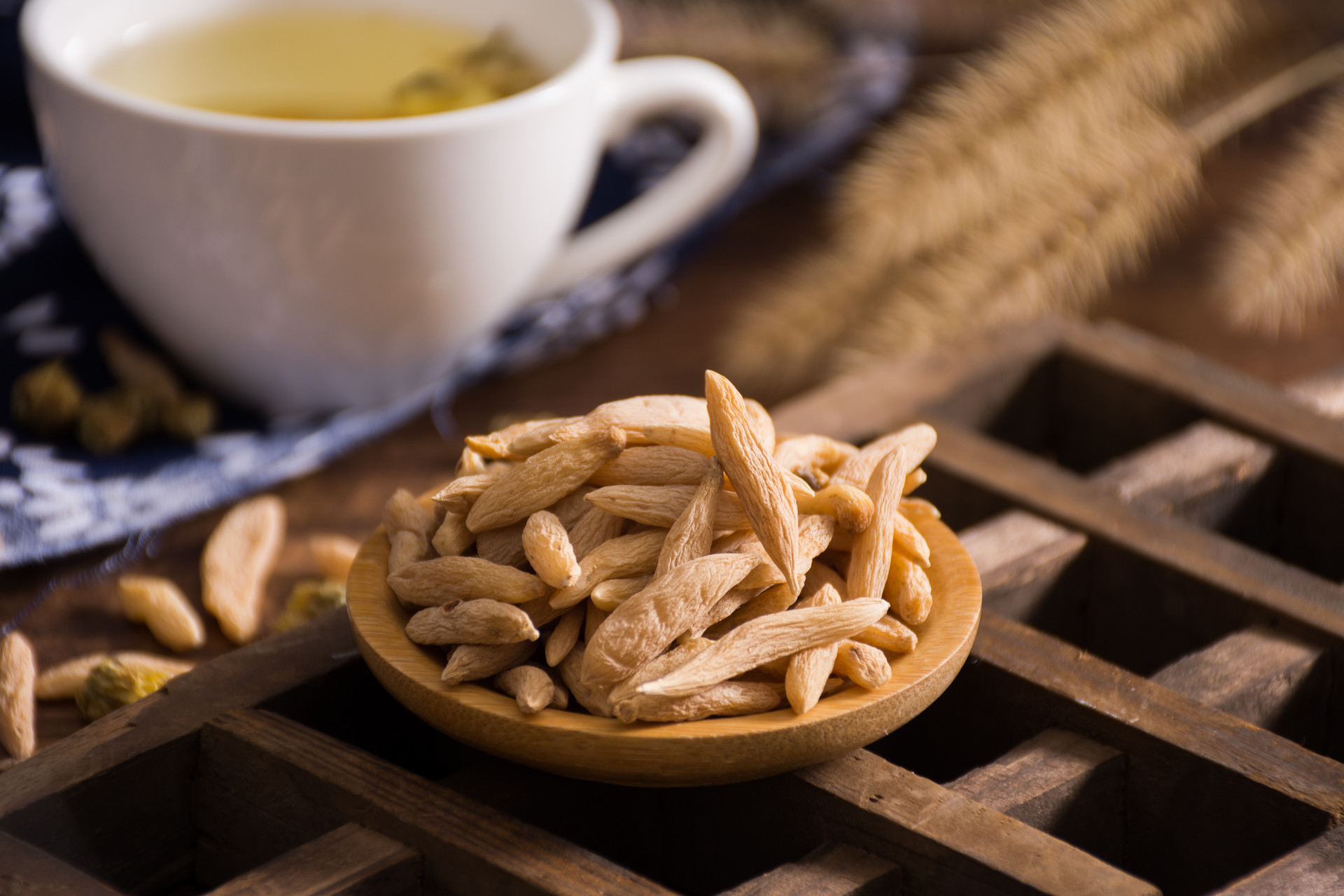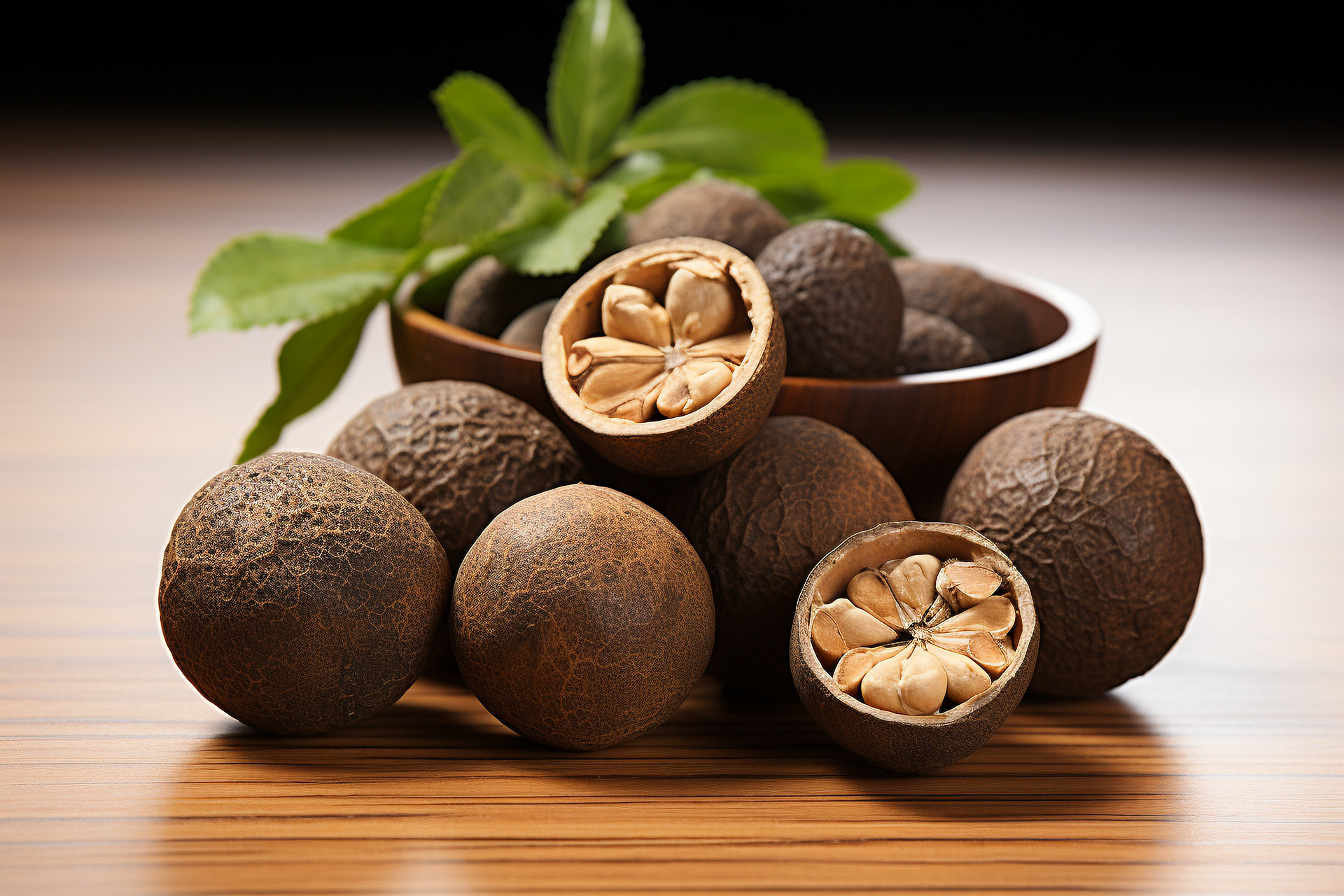Sandalwood, also known as Agarwood or True Sandalwood, is the heartwood of the Sandalwood tree. It can be harvested all year round. After the Sandalwood tree is cut down, it is cut into small sections and the bark and sapwood are removed, leaving only the heartwood for medicinal use. It is classified as a type of aromatic wood in the wood section of the Compendium of Materia Medica and is commonly used in traditional Chinese medicine for regulating qi. It is mainly produced in India, Indonesia, Australia, and also cultivated in Taiwan. There are two types of Sandalwood in the market, namely Yellow Sandalwood and White Sandalwood. It is known for its effects of regulating qi, warming the middle, and relieving stomach pain. It is often used to treat abdominal pain, retching and vomiting, and discomfort in the chest. It is worth noting that some products on the market use Cypress wood sprayed with fragrance to impersonate Sandalwood, so it is important to be able to identify the authenticity.
Modern medicine has shown that Sandalwood has a good effect in treating angina pectoris caused by coronary heart disease. Red Sandalwood tea can effectively relieve clinical symptoms, improve the blood supply situation in electrocardiogram, reduce the severity of angina attacks, and prolong the interval between angina attacks. Sandalwood and Jujube Kernel Decoction can effectively treat angina pectoris. The Coronary Heart Suhe Pill, which is used to treat chest pain caused by cold stagnation and obstruction of the heart meridian, also contains Sandalwood. The fake product, Cypress wood, does not have the medicinal effect of Sandalwood and cannot be used as a substitute for Sandalwood in medicine.
Identification of Authentic Sandalwood
Authentic Sandalwood is mostly cylindrical or slightly flattened, straight, and sometimes slightly curved. It is often sawn into segments of varying lengths, generally 50-100 cm long and 10-20 cm in diameter. The surface is light yellow-brown, and the color becomes darker over time. The surface is smooth and delicate, with fine longitudinal cracks visible. Both ends are flat and neat. The growth rings are not obvious. It has a clear and fragrant smell, a light taste, and a slightly spicy sensation when chewed. The fire test method can be used for identification: when authentic Sandalwood is burned, it emits a strong fragrance and produces a light smoke.
Fake Cypress Wood
The fake Cypress wood has an irregular segmented shape, with a yellow or yellow-brown surface that is rough and has longitudinal grooves and scars. It has obvious growth rings. It has a slight fragrance when smelled, like a strong scent of perfume, and a slightly bitter taste when chewed. When burned, it produces thick smoke and does not have the fragrance of Sandalwood.
- Home /
- Chinese Medicinal Materials /
- Identify /
- Contents
Authentic Sandalwood: Identification and Medicinal Benefits
Everyone Is Watching
-
 The Efficacy and Effects of Honeysuckle in Traditional Chinese Medicine
The Efficacy and Effects of Honeysuckle in Traditional Chinese MedicineHoneysuckle, also known as Lonicera, is a common and valuable plant in traditional Chinese medicine. Since ancient times, honeysuckle has been widely used in the field of traditional Chinese medicin
April 9, 2024 -
 The Benefits and Effects of Ginseng: Exploring the Miraculous Medicinal Treasure
The Benefits and Effects of Ginseng: Exploring the Miraculous Medicinal TreasureGinseng, a widely recognized precious medicinal herb around the world, has been hailed as the "King of Herbs" since ancient times. In Asian regions such as China, Korea, Japan, and Russia, ginseng i
March 26, 2024 -
 Comparing Turmeric, Curcuma, and Zedoary: Promoting Blood Circulation and Regulating Qi
Comparing Turmeric, Curcuma, and Zedoary: Promoting Blood Circulation and Regulating QiTurmeric, Curcuma, and Zedoary are three herbs that all have the ability to promote blood circulation and regulate qi. They are commonly used together in clinical practice, but they do have some sligh
February 22, 2024 -
 Coptis: A Closer Look at its Morphological Characteristics
Coptis: A Closer Look at its Morphological CharacteristicsThe morphological characteristics of Coptis: rhizome, yellow, often branched, densely covered with numerous fibrous roots. Leaves with long petioles; leaf blades slightly leathery, ovate-triangular,
December 22, 2023 -
 Qianghuo: A Powerful Herb for Joint Health and Pain Relief
Qianghuo: A Powerful Herb for Joint Health and Pain ReliefQianghuo is the root of the umbelliferous plant Qianghuo. It has a warm nature, a bitter taste, and enters the bladder and kidney meridians. It has the effects of dispelling exterior cold, expell
December 13, 2023

Hot Picks
-
 1Distinguishing Similar Plant Species: A Comparative Study
1Distinguishing Similar Plant Species: A Comparative StudyRose and Rose The former has a round ball shape, pink or purple color, and elongated sepals. The latter has a slightly spherical shape, mostly purple color, and spherical sepals. North American
February 27, 2024 -
 2Bitter Sophora Root: Identification and Adulterant Testing
2Bitter Sophora Root: Identification and Adulterant TestingBitter Sophora Root, which is long cylindrical in shape, often branches at the lower part, measuring 10-30cm in length and 10-30cm in diameter. The surface is grayish-brown or yellowish-brown, with lo
January 31, 2024 -
 3Hawthorn: A Traditional Chinese Medicine for Digestion and Stasis
3Hawthorn: A Traditional Chinese Medicine for Digestion and StasisHawthorn is a commonly used traditional Chinese medicine. It was first recorded in the Tang Dynasty's "Newly Revised Materia Medica". It has the functions of promoting digestion, resolving food stag
January 28, 2024 -
 4Identifying Genuine Snow Lotus Flower: Characteristics and Differences
4Identifying Genuine Snow Lotus Flower: Characteristics and DifferencesSnow lotus, also known as snow lotus flower, big toe flower, big wood flower, is a flowering herb of the Asteraceae family, including species such as Saussurea laniceps, Saussurea macrophylla, and Sau
December 1, 2023 -
 5Identifying Adulterated Longan Meat: Appearance, Smell, Touch, and Taste
5Identifying Adulterated Longan Meat: Appearance, Smell, Touch, and TasteLongan meat, also known as dried longan, yizhi, or mipi, is the false seed coat of the longan plant, a member of the Sapindaceae family. It has a warm nature and a sweet taste, and enters the heart an
November 28, 2023

